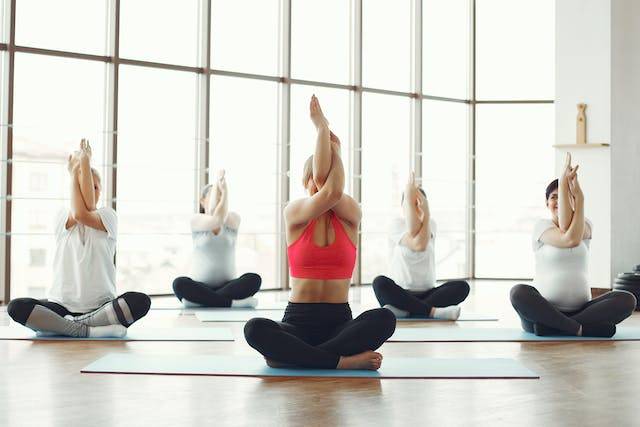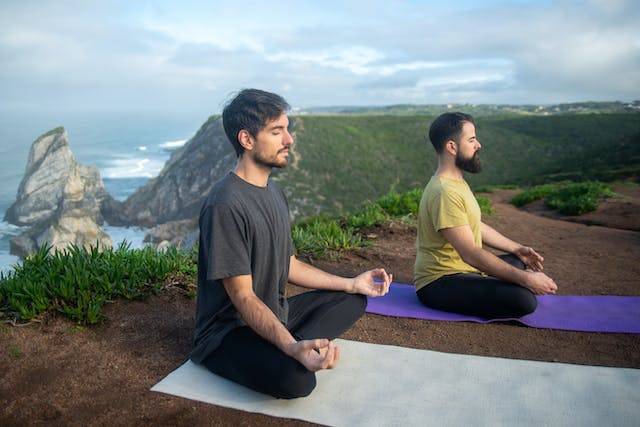Introduction- Let’s strike a healthy bond between Yoga and mental health.
When was the last time you felt at peace?
Did this question make you think hard? Let’s face it — attaining peace in the digital age is no easy feat. Taking off to the mountains or a beach can help you recharge, but it is not a feasible option for many of us.
It’s difficult to catch a break from the daily struggles of life. Maybe the only way you can completely be at peace is by retiring to a forest. Wait, now, don’t start packing your bags so soon. That would be a huge sacrifice on your part. We would like to help you out in a healthier and rational way.
Yoga For Mental Health

Connecting the dots between Yoga and mental health.
You must have seen people around you practicing Yoga to get fitter. But do you know about its several positive impacts on your mental health? Several industry experts have studied this discipline, and all of them have arrived at the same conclusion that practicing Yoga benefits your Mental Health in more ways than one.
This ancient discipline that started in India ages ago is now practiced by scores of people across the globe. It even has a designated day called “International Yoga Day .”There has to be something unique about it.
So roll your mat because we’re going to dive into the enchanting world of Yoga and Mental Health.
How is Yoga Good For Mental Health?
Do you ever feel like:
- Something is missing from your life?
- Your mind is never at peace?
- You’re not content in life?
Experiencing the above-mentioned feelings is extremely normal. Getting overwhelmed with situations and challenges life throws at you is a given. It happens to all of us, whether you’re a student or an adult.
Here’s an honest truth, my friend!
Problems will never end. You must learn to cope with it in a healthy way and let not the pressures of life get the best of you.
According to Harvard Health Publishing, a study published in the journal “Aging and Mental Health” says that Yoga, among a variety of relaxation techniques, was found to be the most effective for anxiety and depression.
Consistent engagement in Yoga Practice has also been shown to increase the production of “feel-good” neurotransmitters like dopamine and serotonin. These chemicals play an important role in regulating mood and emotions, helping to alleviate symptoms of anxiety and depression.
Make Yoga your companion who will help you find your calm in a chaotic world. It’s wholesome and holistic for your body, mind, and soul. All we ask you is to dedicate some of your time to it, and slowly, it will become your refuge for peace and happiness.
Yoga And Mental Health Go Hand In Hand

You must have heard the following statements:
“Do Yoga for weight loss.”
“I knocked off several kilos with Yoga.”
“Yoga helps in digestion.”
“Yoga helped me with my back pain.”
“Do Yoga to reduce your arthritis pain.”
The list of physical benefits of Yoga is big, and many people have reaped its benefits. But we need to realize that it goes far beyond a typical workout. Yoga also improves your mental health. And we advocate the importance of having a good state of mind. Because if your mind is not healthy, your body will bear the brunt.
Let’s break it down and explain the relationship between Yoga and mental health. The term Yoga has originated from the Sanskrit language. It means to join or to unite, indicating a harmony between the body, mind, and soul.
Now you know that Yoga, at its core, is to heal you inside out. We need to leverage the link between Yoga and Mental Health. It is more than dropping kilos and losing inches. It truly enriches your life in every sense.
As per a study published in 2012, Yoga poses help control the sympathetic nervous system and the hypothalamic-pituitary-adrenal system in different groups of people.
It is also important that we address the taboo around Mental Health. Even though there is some awareness around the importance of mental health, the taboo is still widely spread. Look around among your own loved ones and ask yourself the below questions?
- Do you feel comfortable discussing about your mental health issues with your family?
- And if you open up about it, are you dismissed or criticized?
- Are you called weak for having such issues?
Most people will consider you lucky if your family has created a safe space for the members to talk about their mental health issues. You represent a tiny part of the population in our country. The rest of us struggle to open up about it. Wiping out the taboo around mental health is the need of the hour, but we have a long way to go. In the meantime, we suggest you turn to Yoga to improve your mental health. The relationship between Yoga and Mental health is pretty established.
Let’s talk more about how this beautiful discipline improves your mental health.
Let’s Have a Look At Yoga and Its Benefits For Mental Health
We hope to have made you realize the strong connection between Yoga and mental health. Below are some of the benefits of Yoga for mental health.
1. Stress Reduction
A Yoga session a day keeps the stress away.
Stress is an inevitable part of our lives. We experience it right from childhood to adulthood through:
- School/College exams
- Competitive exams
- Job interviews
- Peer pressure
- Adolescence issues
- Relationship issues
- Family issues
- Money issues
This list will never end. Now tell us what a better solution: to sweep your problems under the carpet or to learn how to tackle it in a healthy way.
One of the ways that you can learn how to tackle stress is through Yoga.
As stated by the National Institutes of Health, scientific evidence has proved Yoga to be beneficial for:
- Stress management
- Mental health
- Mindfulness
- Healthy eating
- Weight loss
- Quality sleep
But then, how can Yoga reduce mental stress?
First of all, let’s take a deep breath. Being mindful of your breath can assist you to:
- Calm your nervous system
- Reduce blood pressure
- Lower your heart rate
- Make your anxiety levels drop down naturally
Yoga practitioners often use breathwork to encourage mindfulness and reduce stress.
Staying in the moment is another important part of this discipline. Master the art of staying focused, and nothing can stop you from attaining peace. It is highly therapeutic and one of the most important psychological benefits of Yoga.
You can count on Yoga to help you deal with skyrocketing stress levels by adopting these simple techniques. You will start to reach a calmer and more relaxed state of mind. All you have to do is be consistent to see your body naturally reducing its stress response. You will start realizing that Yoga and Mental Health are interconnected.
2. Better control over your emotions
Have you ever observed how you react to stressful and adverse situations? Can you cope with them? Do you lose your cool?
Humans will experience a range of emotions — positive and negative. Having control over your emotions does not come naturally to everyone.
If you are someone who finds it difficult to keep your emotions in check, we suggest you start working on it. Because negative emotions will only impact your physical health. Remember, the mind and the body are interlinked.
According to research conducted by scientists at the Department of Business Management, College of Horticulture, Dr YS Parmar University of Horticulture and Forestry, adolescents practicing yoga were noted to significantly differ from the non-yoga group on emotional regulation, self-esteem, and feeling components.
Mindfulness, taught by Yoga, helps you to detach from all your emotions. It teaches you to keep your emotions in check and analyze the situation rationally. Staying calm in responding rationally in stressful situations will come to you naturally. Not only physical, but also the emotional benefits of Yoga are profound.
3. Managing Your Anxiety With Ease
Do you ever:
- Worry unnecessarily
- Feel restless
- Feel irritable
These are a few indicators of anxiety, and ignoring them can seriously hamper your life. Performing your daily tasks can become a major challenge.
It should not come as a surprise to you when we say that many people have a certain amount of anxiety. Experiencing anxiety is a by-product of the 21st century.
A review of eight studies conducted in 2005 found that yoga was beneficial to people living with conditions such as OCD, examination anxiety, anxiety, neurosis, etc.
Take a deep breath and make Yoga your savior in times of anxiety. You must have heard of Pranayama. It is simply a controlled breathing technique that teaches you to breathe slowly and deeply.
Someone with an anxiety disorder will experience rapid and shallow breaths. By practicing Pranayama regularly, they will be able to slow down their breathing and reduce their level of anxiety.
4. Tackles Depression And Elevates Mood
Do you constantly feel sad, hopeless, lost or frustrated?
Firstly, please do not dismiss these feelings. Depression is very real, and scores of people are going through it. Please don’t pass it off as a temporary state of sadness. The fact that so many people talk about it validates its existence.
As per the Harvard Mental Health Letter, yoga has been found to help with anxiety and depression.
Let us help you understand exactly how does Yoga affect your mental health.
Yoga enables the release of your favorite hormones: endorphins. You can even call them natural painkillers. These happy hormones will instantly elevate your mood and cheer you up.
In this way, Yoga encourages you to keep a positive mindset. It makes it easier to start acknowledging your emotions without any form of judgment. With the help of Yoga, you can begin to accept all your negative feelings and work towards healing.
5. Improved Sleep cycle
Sleeping like a baby is a luxury in adult life.
After a certain age, getting a restful sleep becomes challenging. Life’s stress and worries get the better of us.
Practicing Yoga helps you sleep tight. As per a 2014 study in the journal Alternative Therapies In Health and Medicine, Yoga has been found to improve both sleep and the overall quality of life for adults experiencing insomnia.
The deep relaxation experienced during a Yoga session will be automatically carried over to your bedtime. Practice it regularly to enjoy a peaceful sleep. Sweet dreams.
6. Ability To Stay Focused And Improved Cognitive Function
The digital age is responsible for our shrinking attention span.
But Yoga can help here as well. According to a study conducted in 2020, yoga helps in stimulating areas of the brain responsible for motivation, executive functioning, attention, and neuroplasticity.
The physical postures and deep breathing taught in Yoga help you to improve your concentration. Practice it to stay focused on the daily chores of your life. Eventually, you will be able to do it without realizing it.
7. Body Image and Self-Esteem
Are you guilty of
- Using filters when posting pictures on social media
- Using apps to trim your various body parts in pictures
- Using make-up to look fair
- Using filters for flawless skin and a fair complexion
These apps exist because we want to be the best version of ourselves, even if it’s fake. In order to strive for perfection, we forget to embrace our flaws.
In times like these, when you don’t feel good enough, we urge you to turn to Yoga. This discipline truly promotes self-love.
According to a study conducted in 2018, Yoga can make people feel better about their bodies. They appreciate their bodies more, feel proud of their yoga skills, have more self-confidence, and see that all kinds of bodies can do yoga.
Yoga has never been about achieving a specific body type. It aims to make you mentally and physically healthy rather than looking a certain way. Practicing Yoga can help you develop an appreciation for yourself.
So make Yoga like your mirror. A mirror that reflects your inner beauty and makes you realize your worth. Let it be your guru that guides you towards self-compassion. Let it help you accept and embrace all your flaws. Let it help you realize that the idea of perfection itself is imperfect. Let it help you become realistic. By now, you must have realized that Yoga and mental health are closely linked.
Conclusion:
Yoga is therapy for mental health.
With this blog, we hope that we have been able to change your mind about the benefits of yoga for mental health. We encourage you to break the taboo around mental health and open up about your mental health needs. We hope you do know that it’s okay not to be okay. And we hope that you are able to embrace Yoga to support your own mental health needs.
Yoga is like a warm hug when life gets overwhelming. It comes to your rescue in a world full of anxiety and stress. Let it help you make your life easy and peaceful. Make it your savior. Lastly, consider Yoga and your mental health as allies.
Wishing you a healthy mind. Namaste.
Apart from Yoga, many other ways can keep your mental health in excellent shape. Click here to have a look at the activities that can improve your mental health!
To continue learning about Yoga and mental health, subscribe to Your Mental Health Pal.


This is so good to know. Thanks for sharing.
You’re welcome!